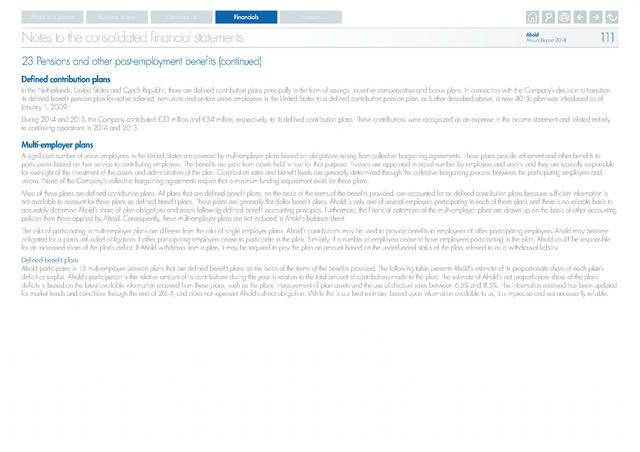Notes to the consolidated financial statements
23 Pensions and other post-employment benefits (continued)
Defined contribution plans
Multi-employer plans
Ahold at a glance
Business review
Governance
Financials
Ahold
Annual Report 2014
In the Netherlands, United States and Czech Republic, there are defined contribution plans principally in the form of savings, incentive compensation and bonus plans. In connection with the Company's decision to transition
its defined benefit pension plan for active salaried, non-union and certain union employees in the United States to a defined contribution pension plan, as further described above, a new 401(k) plan was introduced as of
January 1, 2009.
During 2014 and 2013, the Company contributed €33 million and €34 million, respectively, to its defined contribution plans. These contributions were recognized as an expense in the income statement and related entirely
to continuing operations in 2014 and 2013.
A significant number of union employees in the United States are covered by multi-employer plans based on obligations arising from collective bargaining agreements. These plans provide retirement and other benefits to
participants based on their service to contributing employers. The benefits are paid from assets held in trust for that purpose. Trustees are appointed in equal number by employers and unions and they are typically responsible
for oversight of the investment of the assets and administration of the plan. Contribution rates and benefit levels are generally determined through the collective bargaining process between the participating employers and
unions. None of the Company's collective bargaining agreements require that a minimum funding requirement exists for these plans.
Most of these plans are defined contribution plans. All plans that are defined benefit plans, on the basis of the terms of the benefits provided, are accounted for as defined contribution plans because sufficient information is
not available to account for these plans as defined benefit plans. These plans are generally Rat dollar benefit plans. Ahold is only one of several employers participating in each of these plans and there is no reliable basis to
accurately determine Ahold's share of plan obligations and assets following defined benefit accounting principles. Furthermore, the financial statements of the multi-employer plans are drawn up on the basis of other accounting
policies than those applied by Ahold. Consequently, these multi-employer plans are not included in Ahold's balance sheet.
The risks of participating in multi-employer plans are different from the risks of single employer plans. Ahold's contributions may be used to provide benefits to employees of other participating employers. Ahold may become
obligated for a plan's unfunded obligations if other participating employers cease to participate in the plan. Similarly, if a number of employers cease to have employees participating in the plan, Ahold could be responsible
for an increased share of the plan's deficit. If Ahold withdraws from a plan, it may be required to pay the plan an amount based on the underfunded status of the plan, referred to as a withdrawal liability.
Defined benefit plans
Ahold participates in 13 multi-employer pension plans that are defined benefit plans on the basis of the terms of the benefits provided. The following table presents Ahold's estimate of its proportionate share of each plan's
deficit or surplus. Ahold's participation is the relative amount of its contributions during the year in relation to the total amount of contributions made to the plan. The estimate of Ahold's net proportionate share of the plans'
deficits is based on the latest available information received from these plans, such as the plans' measurement of plan assets and the use of discount rates between 6.5% and 8.5%. The information received has been updated
for market trends and conditions through the end of 2014, and does not represent Ahold's direct obligation. While this is our best estimate, based upon information available to us, it is imprecise and not necessarily reliable.

